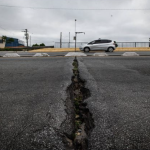Bridges
The useful life of a work of art depends on the systematic accompaniment of its integrity.
From visual inspection to methods of dynamic analysis, there are several research alternatives.
ASSESSMENT OF STRUCTURAL BEHAVIOR AND SAFETY OF THE WORK
Visual inspection and non-destructive testing Visual inspection is an important methodology for monitoring the condition of civilian structures, identifying pathologies such as cracks and cracks, degradation of support devices, concrete carbonation, exposed reinforcement, among others.
In conjunction with visual inspection, non-destructive testing is a great tool for detecting additional structure information.
Among them, we can cite:
- compression test;
- sclerometry;
- ultrasonography;
- extensometry;
- monitoring of the movement of cracks and their depth;
- evaluation of tension and corrosion levels of reinforcement.
STATIC AND DYNAMIC TESTS
As a static test in bridges, a static load test can be performed according to current standards, measuring the displacements and deformations resulting from applied loads in stages.
The dynamic tests are used to obtain the modal properties of the bridge, such as natural frequencies and vibration modes, in which dynamic loads are applied to read the accelerations and / or speeds.
THEORETICAL-EXPERIMENTAL MATHEMATICAL MODEL
Elaborated from the mechanical properties of the materials, obtained experimentally, the numerical model is a very reliable tool to evaluate the behavior of the structure, even under various loading conditions. This tool guarantees the safety of the structure in its real state.
MONITORING AND DYNAMIC EXPERIMENTAL ANALYSIS
Each situation requires one type of analysis: monitoring of existing or induced vibrations by a mechanical generator. Among the main advantages of dynamic monitoring are:
- Non-destructive technique used in the evaluation of structural integrity
- Accuracy in structural evaluation and identification of anomalies
- Methodology of remarkable efficiency for evaluating the behavior of structures
- Possibility of continuous and comparative structural evaluation with the behavior of the integral structure
The excitation of the structure can be environmental or forced and for the measurement accelerometers are used positioned at strategic points of the structure. The analysis is performed using the Operational Modal Analysis (AOM) and / or the Classical Experimental Modal Analysis (EMA), respectively. For the dynamic test with forced vibration, IEME Brazil has Vibrodina, a mechanical vibration generator. The data obtained in this analysis are processed by the EMA, allowing the accurate evaluation of possible structural damages.
STUDIES ON ALKALI-AGGREGATE REACTION (RAA)
The Alkali-Aggregate reaction (RAA) is a pathology that can compromise the useful life of the dam. Here’s how we can help you tackle this problem:
- Detailed inspection of structural elements
- Microscopic and petrographic analysis of concrete samples
- Monitoring of the movement of cracks and their depth
- Numerical models for evaluating concrete expansion
- Solutions to mitigate the effects of RAA


